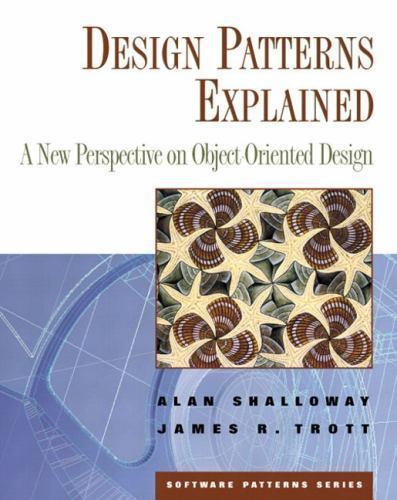Picture 1 of 1

Stock photo

Picture 1 of 1

Stock photo

Software Patterns Ser.: Design Patterns Explained : A New Perspective on Object-Oriented Design by James Trott and Alan Shalloway (2001, Trade Paperback)

AlibrisBooks (450781)
98.5% positive Feedback
Price:
US $61.13
Approximately£45.91
+ $19.95 postage
Returns:
30 days return. Buyer pays for return postage. If you use an eBay delivery label, it will be deducted from your refund amount.
Condition:
New Trade paperback
Oops! Looks like we're having trouble connecting to our server.
Refresh your browser window to try again.
About this product
Product Identifiers
PublisherAddison Wesley Professional
ISBN-100201715945
ISBN-139780201715941
eBay Product ID (ePID)1898736
Product Key Features
Number of Pages368 Pages
LanguageEnglish
Publication NameDesign Patterns Explained : a New Perspective on Object-Oriented Design
Publication Year2001
SubjectSoftware Development & Engineering / General, Programming / Object Oriented
TypeTextbook
AuthorJames Trott, Alan Shalloway
Subject AreaComputers
SeriesSoftware Patterns Ser.
FormatTrade Paperback
Dimensions
Item Height0.7 in
Item Weight20.7 Oz
Item Length9.2 in
Item Width7.3 in
Additional Product Features
Intended AudienceScholarly & Professional
LCCN2001-031645
Dewey Edition22
IllustratedYes
Dewey Decimal005.1/17
Table Of ContentPreface. From Object Orientation to Patterns to True Object Orientation. From Artificial Intellegence to Patterns to True Object Orientation. I. AN INTRODUCTION TO OBJECT-ORIENTED SOFTWARE DEVELOPMENT. 1. The Object-Oriented Paradigm. Before The Object-Oriented Paradigm: Functional Decomposition. The Problem of Requirements. Dealing With Changes: With Functional Decomposition. Dealing with Changing RequirementS. The Object-Oriented Paradigm. Special Object Methods. Summary. 2. The UML - The Unified Modeling Language. Overview. What is the UML? Why Use the UML? The Class Diagram. Interaction Diagrams. Summary. II. THE LIMITATIONS OF TRADITIONAL OBJECT-ORIENTED DESIGN. 3. A Problem that Cries Out for Flexible Code. Overview. Extracting Information from a CAD/CAM System. Understand the Vocabulary. Describe the Problem. The Essential Challenges and Approaches. Summary. 4. A Standard Object-Oriented Solution. Overview. Solving With Special Cases. Summary. Supplement: C++ Code Examples. III. DESIGN PATTERNS. 5. An Introduction to Design Patterns. Overview. Design Patterns Arose from Architecture and Anthropology. Moving from Architectural to Software Design Patterns. Why Study Design Patterns. Other Advantages to Studying Design Patterns. Summary. 6. The Facade Pattern. Overview. Introducing the Facade Pattern. Learning the Facade Pattern. Field Notes: The Facade Pattern. Relating the Facade Pattern to the CAD/CAM Problem. Summary. 7. The Adapter Pattern. Overview. Introducing the Adapter Pattern. Learning the Adapter Pattern. Field Notes: The Adapter Pattern. Relating the Adapter Pattern to the CAD/CAM Problem. Summary. Supplement: C++ Code Examples 8. Expanding Our Horizons. Overview. Objects the Old Way and the New Way. Encapsulation the Old Way and the New Way. Find What is Varying and Encapsulate It. Commonality / Variability and Abstract Classes. Summary. 9. The Bridge Pattern. Overview. Introducing the Bridge Pattern. An Observation about Using Design Patterns. Learning the Bridge Pattern: An Example. The Bridge Pattern In Retrospect. Field Notes: Using the Bridge Pattern. Summary. 10. The Abstract Factory Pattern. Overview. Introducing the Abstract Factory Pattern. Learning the Abstract Factory Pattern: An Example. Learning the Abstract Factory: Implementing It. Field Notes: The Abstract Factory. Relating the Abstract Factory Pattern to the CAD/CAM Problem. Summary. Supplement: C++ Code Examples. IV. PUTTING IT ALL TOGETHER: THINKING IN PATTERNS. 11. How Do Experts Design? Section Overview. Overview. Building by Adding Distinctions. Summary. 12. Solving the CAD/CAM Problem with Patterns. Overview. Review of the CAD/CAM Problem. Thinking in Patterns. Thinking in Patterns: Step 1. Thinking in Patterns: Step 2A. Thinking in Patterns: Step 2B. Thinkin
SynopsisDesign Patterns Explained: A New Perspective on Object-Oriented Design draws together the principles of object-oriented programming with the power of design patterns to create an environment for robust and reliable software development. Packed with practical and applicable examples, this book teaches the student to solve common programming problems with patterns--and explains the advantages of patterns for modern software design. Beginning with a complete overview of the fundamentals of patterns, Design Patterns Explained stresses the importance of analysis and design. The authors clearly demonstrate how patterns can facilitate the overall development process. Throughout the book, key object-oriented design principles are explained, along with the concepts and benefits behind specific patterns. With illustrative examples in C++ and Java, the book demystifies the "whys," "why nots," and "hows" of patterns and explains pattern implementation., A beginner's guide to succeeding with design patters, this text provides practical object-oriented design techniques and example Java code.
LC Classification NumberQA76.9.O35S52 2001
All listings for this product
Be the first to write a review


























